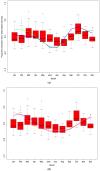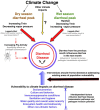Climate change is likely to worsen the public health threat of diarrheal disease in Botswana
- PMID: 23531489
- PMCID: PMC3709313
- DOI: 10.3390/ijerph10041202
Climate change is likely to worsen the public health threat of diarrheal disease in Botswana
Abstract
Diarrheal disease is an important health challenge, accounting for the majority of childhood deaths globally. Climate change is expected to increase the global burden of diarrheal disease but little is known regarding climate drivers, particularly in Africa. Using health data from Botswana spanning a 30-year period (1974-2003), we evaluated monthly reports of diarrheal disease among patients presenting to Botswana health facilities and compared this to climatic variables. Diarrheal case incidence presents with a bimodal cyclical pattern with peaks in March (ANOVA p < 0.001) and October (ANOVA p < 0.001) in the wet and dry season, respectively. There is a strong positive autocorrelation (p < 0.001) in the number of reported diarrhea cases at the one-month lag level. Climatic variables (rainfall, minimum temperature, and vapor pressure) predicted seasonal diarrheal with a one-month lag in variables (p < 0.001). Diarrheal case incidence was highest in the dry season after accounting for other variables, exhibiting on average a 20% increase over the yearly mean (p < 0.001). Our analysis suggests that forecasted climate change increases in temperature and decreases in precipitation may increase dry season diarrheal disease incidence with hot, dry conditions starting earlier and lasting longer. Diarrheal disease incidence in the wet season is likely to decline. Our results identify significant health-climate interactions, highlighting the need for an escalated public health focus on controlling diarrheal disease in Botswana. Study findings have application to other arid countries in Africa where diarrheal disease is a persistent public health problem.
Figures









References
-
- Collier P., Conway G., Venables T. Climate change and Africa. Oxf. Rev. Econ. Pol. 2008;24:337–353. doi: 10.1093/oxrep/grn019. - DOI
-
- Murray C.J.L., Vos T., Lozano R., Naghavi M., Flaxman A.D., Michaud C., Ezzati M., Shibuya K., Salomon J.A., Abdalla S. Disability-adjusted life years (DALYs) for 291 diseases and injuries in 21 regions, 1990–2010: A systematic analysis for the global burden of disease study 2010. Lancet. 2013;380:2197–2223. - PubMed
-
- Pruss-Ustun A., Corvalan C. How much disease burden can be prevented by environmental interventions? Epidemiology. 2007;18:167–178. - PubMed
-
- Black R.E., Cousens S., Johnson H.L., Lawn J.E., Rudan I., Bassani D.G., Jha P., Campbell H., Walker C.F., Cibulskis R. Global, regional, and national causes of child mortality in 2008: A systematic analysis. Lancet. 2010;375:1969–1987. - PubMed
Publication types
MeSH terms
LinkOut - more resources
Full Text Sources
Other Literature Sources
Medical

